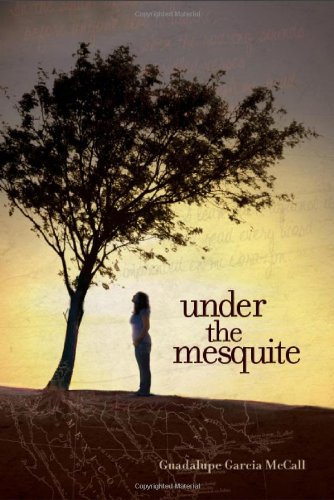
BIBLIOGRAPHY
McCall, Guadalupe Garcia. 2011. Under the Mesquite. Lee & Low Books Inc. ISBN: 9781600604294
PLOT SUMMARY
Lupita comes from a large Mexican American immigrant family that lives in Eagle Pass, Texas. She is happy with her life and loves her family dearly. She's enjoys acting and writing. She learns that her mother has cancer and is sadden by the possibility of losing her dear mother. Her mother is the "glue" that holds the family together but Lupita takes on the motherly responsibilities in order to help save her mother's life. Her mother is later cared for in an out of town clinic and Lupita gladly accepts the challenges in order to move her family forward. She quickly realizes that it is a struggle to keep up with her studies, house chores, and her siblings. She finds comfort in the company of a mesquite tree where she writes her thoughts.
CRITICAL ANALYSIS
The author used vocabulary that made it easy to comprehend and enjoy the story. She included a glossary to define the Spanish words used in the text. I really connected with this book in more than one way. I can relate to Lupita in that I am also Mexican American, a first generation college grad, and my own mother makes tortillas. I can still see my "mami" making tortillas every time I came home from college. The smell, taste, and feel of those tortillas came back to me. Lupita is like the mesquite tree in that although she's had losses and struggles she still finds the strength to jump back and grow from what is left.
AWARDS AND REVIEW EXCERPTS
2012 Pura Belpre Award
2012 William C. Morris Debut Award Finalist
2013 Tomas Rivera Children's Book Award
"A promising, deeply felt debut." --Kirkus Reviews
“This stunning debut novel in verse chronicles the teenage years of Lupita, a character drawn largely from the author s own childhood...The simplicity of the story line belies the deep richness of McCall’s writing.” --School Library Journal
“Told in verse sprinkled with Spanish terms (a glossary is included), this story of Lupita s high-school years details her increasing responsibility within her large Mexican American family after Mami is diagnosed with cancer.” --Booklist
CONNECTIONS
1) Have students use poetry to tell about their own lives. Use a QR code to link to the student's poem at Open House.
2) Have students keep a journal.
Writing stems to promote writing:
Have you had any experiences that has changed you?
What do you do to overcome difficult situations?
If you had to pick something to represent you, what would it be? Why?
3) Research and Discuss the Mexican-American culture, music, art, and foods.
